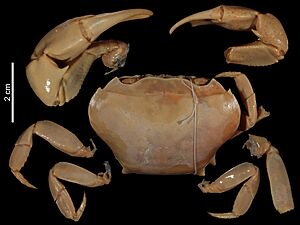Oziotelphusa facts for kids
Quick facts for kids Oziotelphusa |
|
|---|---|
 |
|
| Oziotelphusa bouvieri | |
| Scientific classification | |
| Kingdom: | |
| Phylum: | |
| Subphylum: | |
| Order: | |
| Infraorder: | |
| Family: |
Gecarcinucidae
|
| Genus: |
Oziotelphusa
Müller, 1887
|
| Type species | |
| Telphusa hippocastanum Müller, 1887
|
|
Oziotelphusa is a group, or genus, of freshwater crabs. These crabs live in fresh water, like rivers and streams, not in the ocean. They belong to a family of crabs called Gecarcinucidae.
You can find Oziotelphusa crabs in Sri Lanka and parts of southern India. This includes areas like Kerala, Tamil Nadu, and southern Karnataka.
These crabs were once thought to be part of a different family, called Parathelphusidae. But scientists have now learned that Parathelphusidae is actually the same as Gecarcinucidae. So, all these crabs are now grouped under the Gecarcinucidae family.
Discovering Oziotelphusa Crabs
There are fifteen different types, or species, of Oziotelphusa crabs known to scientists. Each of these species has its own unique features and places where it lives.
How Scientists Track Crab Populations
All fifteen species of Oziotelphusa crabs are listed on the IUCN Red List. This list helps us understand how safe or endangered different animals are around the world. Here's what some of the terms mean:
- LC: Least Concern - These species are doing well and are not currently at risk.
- VU: Vulnerable - These species might be in danger in the future if things don't change.
- EN: Endangered - These species are at a high risk of disappearing forever.
- CR: Critically Endangered - These species are in extreme danger and could become extinct very soon.
- DD: Data Deficient - Scientists don't have enough information about these species to know if they are safe or at risk.
For example, Oziotelphusa ceylonensis and Oziotelphusa mineriyaensis are considered Least Concern. This means they are found in many places in Sri Lanka and are not currently threatened.
However, some species are much rarer. Oziotelphusa intuta and Oziotelphusa kodagoda are both Critically Endangered. This means they are only known from one very specific place, making them very vulnerable.
Scientists continue to study these crabs to learn more about them and help protect their homes.
Images for kids


